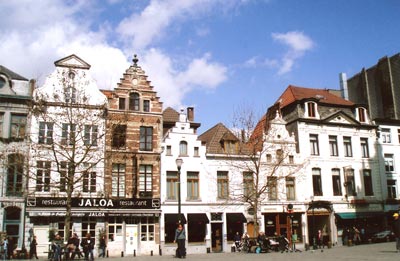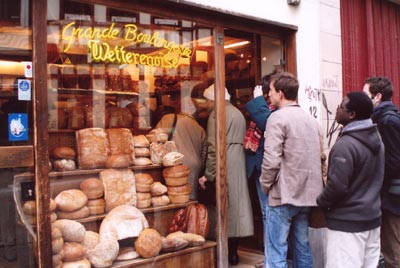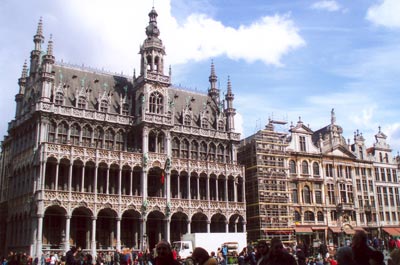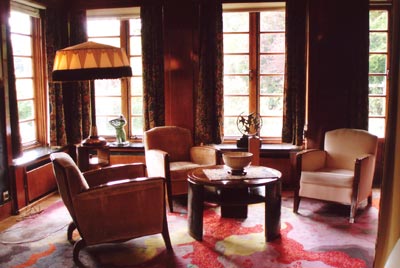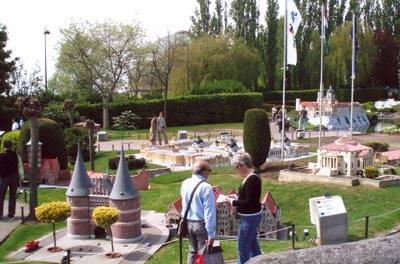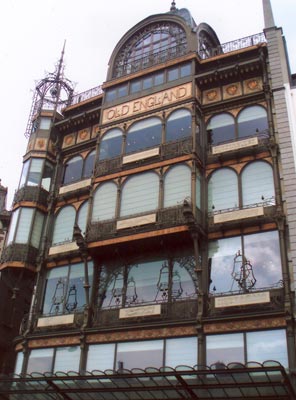Discovering much to see and do on a 5-week stay in Brussels
by Marilyn Lutzker, New York, NY
A well-preserved medieval center, dozens of world-class museums, a wealth of Art Nouveau architecture, affordable antique and flea markets and more than 1,500 restaurants are enough to belie Brussels’ reputation for being boring. Visitors will find Brussels a joy for looking, learning, walking and eating.
Where to stay
Brussels is divided between Lower Town and Upper Town. On our first visit in 2002, my friend and I stayed in the Avenue Louise area of Upper Town. This is a comfortable, upper-middle-class area of residences and hotels that is quiet, with plenty of restaurants and upscale shopping. Although the neighborhood is a bit bland, the Royal Museums of Fine Arts, the Musical Instruments Museum and my favorite flea market are within a reasonable walking distance.
Lower Town is the medieval center of Brussels, and it was our choice for this April ’08 visit. With its narrow, winding streets radiating out from the Grand Place and its potpourri of shops, restaurants and cafés, this is considered the center of the city. It is vibrant, busy and noisy!
Although the Grand Place draws tourists by the busload, it remains an established residential neighborhood. Supermarkets, cheese stores, boulangeries and barbershops vie for space with sneaker stores, souvenir shops and fashionable boutiques. Sidewalk kiosks sell ice cream and waffles.
If you choose to stay in this area, be careful that your accommodations are not located on a street with noisy bars or nightclubs.
Getting around
Brussels is a spread-out city with a complex public transportation system of subways (Metro), trams and buses. They are frequently crowded (people tend to congregate at the doors, but there always seems to be room inside) but clean and fast, and many stations include interesting sculptures and murals.
Unfortunately, I never located one map which included all forms of transportation. The Metro map was clear and easy to use; the bus/tram map was much less so. Very often, if you are reasonably vigorous, the easiest way to get around is to walk.
The Grand Place
Seldom does a plaza so richly deserve the appellation “grand.” Brussels’ Grand Place is big, it’s open, and it dazzles the eyes with a harmonious mixture of medieval and Flemish Renaissance architecture. A UNESCO World Heritage Site, it deserves all the encomiums that are lavished upon it by guidebook writers.
A center of the town’s trade and commerce in the 11th century, it has been dominated by the towering spires and arcaded façade of its Town Hall since 1402. Brussels was fortunate that this Gothic extravaganza was built of stone, because in 1695 the mostly wooden guildhalls lining the other three sides of the square were completely destroyed during a war with the French. But the Flemish guilds were not to be undone, and in under five years they rebuilt the square into one of the world’s best Baroque ensembles, this time in stone.
Although each guild had to adapt its design to the same small plots of land, each building is unique. Using the somewhat vague baroque vocabulary of the so-called Flemish Renaissance, the buildings are a mix of pedimented roofs, mullioned windows and a plethora of sculptured decorations, including allegorical figures, warriors, saints, knights and a wealth of flora and fauna.
Brussels is heaven for the architecture enthusiast, and the Grand Place is just the beginning.
Artful architecture
There are said to be 2,000 surviving Art Nouveau buildings in Brussels, mostly in residential districts that surround the city center. There are commercial tours which cover some of them, and most guidebooks, as well as the tourist office, have maps and walking tours of the areas with the largest numbers of examples.
Victor Horta (1861-1947) was one of the world’s foremost exponents of Art Nouveau, but disappointment was my reaction when I approached the Horta Museum (25, rue Américaine), located in the St. Gilles district. A narrow yellow brick rowhouse with a few restrained decorative touches around the windows and balcony railings, it certainly was not what I expected.
But Horta designed this house for himself, and he kept its delights for his private enjoyment. The building’s interior is filled with light, and the flowing spaces are articulated with sinuous Art Nouveau curves in bent wood and wrought iron. Most astounding are the details — drawer pulls, closet hardware, door handles — each a marvel of Art Nouveau design.
The house has been restored to its original state. It is not a house holding a museum but a house which is a museum, and it was a privilege to experience it.
The Horta house was a bit hard to find. We took Tram 81 from the Gare du Midi Metro station to the Janson stop.
David Van Buuren, a Dutch banker, and his wife, Alice, built their home in 1929. As Horta’s house exemplifies Art Nouveau, the Van Buuren House (41, Av. L. Errera) — and everything in it — is pure Art Deco.
The elegant lines of the upholstered furniture; the polished surfaces of tables and chairs whose simple lines recall industrial design; the exotic woods; lampshades; ashtrays, and carpets: everything throughout the house forms a harmonious whole. The art collection, including works by some of the most famous painters of the era, complements the furnishings.
The Van Buuren House is omitted from most guidebooks, but if you are interested in the architecture, furniture and decorations of the 1920s and ’30s, I’d recommend an afternoon here. It is like being on an old movie set.
The period gardens which surround the house, including a Victorian-style maze, are themselves worth the trip. Take Tram 92 to Square Vanderkinderen.
Marvelous museums
The main building of the Royal Museums of Fine Arts (Place Royal 3) actually houses two museums: the Museum of Ancient Art and the Museum of Modern Art.
Most visitors go to see the rare, world-famous examples of 15th-century Flemish art. Everything beyond that (and there is a great deal beyond that) is icing on the cake. But what icing! From Gauguin and Brueghel to Magritte and Rubens, the world of Western European art history awaits in both the historical and modern collections.
The modern works have been installed in eight below-ground levels, accessed by a combination of stairs, elevators and escalators. As you walk down, you gradually move from mid-19th-century works to contemporary. Then take the room-size elevator back up — it’s the only elevator I have ever seen with seats!
The No. 95 bus and the No. 92 and 94 trams stop in front of the museum.
Sometimes great things come in great containers. One of the world’s most spectacular examples of Art Nouveau architecture, a small 1899 department store has been converted into Brussels’ Musical Instruments Museum (rue Montagne de la Cour 2). I went to see the building with its glass-and-wrought-iron façade and curvilinear decorations, but I fell in love with its contents.
Nearly 1,200 instruments (out of a collection of 7,000) are on display; comfortable infrared earphones with superb sound quality bring them to life. Visitors can stand directly in front of a case and hear music highlighting the instruments contained inside — a feast for the eyes and ears.
The Musical Instruments Museum is about two blocks from the Royal Museums of Fine Arts. It has an expensive restaurant on the top floor with magnificent views of the city.
Opened in 1898 by King Leopold II, the Royal Museum for Central Africa (Leuvensesteenweg 13) was designed to display the ethnological and archaeological spoils of Belgium’s imperialistic intrusion into Central Africa.
When we visited in 2001, although the museum administration obviously was trying to update both the ideology and displays within the museum, its history was clear. By the spring of 2008, much more had been accomplished.
While acknowledging its history, the museum has updated both labels and displays, and recently it has offered special exhibits on the environment and an updated, balanced presentation on the history of Central Africa.
There is much to admire: some excellent animal dioramas; dozens of extraordinary 19th-century sculptures and fabrics; baskets, pots and other objects of daily life, and a broad array of historical artifacts.
Just outside the border of Brussels in the district of Tervuren, the museum is housed in an old palace surrounded by a lovely French garden complete with walking paths and a large pond. Tram 44 from Metro station Montgomery takes you on a lovely ride through suburbs and through the forests of the Parc du Cinquantenaire on the way to the museum.
More museums
Brussels has many other museums (the official guide lists 96). Some (the Costume & Lace Museum, the Chinese Pavilion & Japanese Tower and the National Museum of the Resistance) contained exhibits that we found beautiful and/or interesting. Others (museums devoted to comic strips, chocolate, beer, fencing, cars, streetlamps, police, radiology, etc.) perhaps will appeal to more specialized tastes.
With almost 260 square feet of miniature buildings representing all the countries of the European Union, Mini-Europe is one of those places that kids always love and adults either enjoy or hate.
Winding paths take you from the Eiffel Tower to the Houses of Parliament and from Budapest’s elaborate Art Deco swimming emporium to a Spanish bullring, while miniature trains chug through the landscapes, boats navigate miniature rivers and lakes, and Mount Vesuvius erupts at the touch of a button. Yes, it’s kitschy, but I loved it.
To get there, take the Metro to stop Heysel, about 15 minutes from the Bourse. On your return, if you have the time and enjoy interesting cityscapes and/or have really tired feet, take Tram 23, which runs between Heysel and Gare du Midi. It’s a one-hour ride which initially passes through charming suburban neighborhoods offering some first-class examples of early and mid- 20th-century homes. As you get closer to the city, the houses get smaller and the neighborhoods get a bit grittier, but they are still interesting.
Eating and drinking
If nutrition were not an issue, one could live happily in Brussels on bread and chocolate. We sampled both in many places and, although there were differences, they all were wonderful. It almost doesn’t matter what goes into that sandwich if the bread is fresh from the boulangerie.
And then there is the street food. After trying to resist the tempting aroma coming from the waffle vendor’s on the corner, I decided that it really would be all right to sample street food in Brussels. What a great decision!
The waffles are really good; I preferred mine plain, but they are available with chocolate or whipped cream and strawberries. And the ice cream is even better; the flavors are intense, and the texture is more Italian than French.
One day I broke every rule in the book and did what the locals were doing. I stopped at a friterie and had a large cone of French fries for lunch. If I eat only fried potatoes for one meal, how bad can it be?
In the Avenue Louise area, Therese et Dominique (rue de Joncker, 23), located one block from the corner of Louise and Toison d’Or, serves cold sandwiches and salads. Six years ago we ate lunch there regularly, and I had been waiting eagerly to return.
Open only for lunch, the restaurant always has a long line of people waiting patiently to be served. Therese and Dominique chat cheerfully with regular customers while quickly and efficiently compiling sandwiches and salad plates to order.
Brussels may be less expensive than Paris or London, but, with the dollar on its own slippery slope, even Brussels was costly, so we were startled by the low prices at Therese et Dominique.
A heaping plate of assorted cooked and raw veggies with a basket of bread, enough for two, cost €5.50 ($8.70), and a large, hero-size sandwich of sliced egg with salad was only €3 ($4.75).
Around the Grand Place and the Bourse we found a number of noteworthy eateries. Chez Léon (18 rue des Bouchers) offers fast, pleasant service in an old, established, traditional restaurant. Everyone goes there for mussels and fries. I can’t say if they’re the best in Brussels, but they certainly are good.
The “Moules spéciales,” served in a traditional black pot, cost €19.25 ($30.50); however, the “Formule Léon,” buried a bit on the menu, was a better buy. For €14.50 ($23) we got fewer mussels, served in a soup bowl, plus a glass of beer, but with the ample amounts of frites that came with the dish, we found the number of mussels to be more than adequate for one person.
A glass of house white wine cost €3.15.
We were tempted to skip Falstaff (rue Henri Maus 19), as it’s large, is mentioned in all the guidebooks and looks and sounds like it might be a tourist trap. But it was close, the prices were reasonable and I really wanted to see its much-touted Art Nouveau interior, which features narrow bands of dark wood bent in traditional curves surrounding mirrors and stained-glass windows plus what appeared to be the original chandeliers.
The atmosphere was pleasant, the service was fast and the food was really good. The waterzooi gantois, with half a chicken swimming in a creamy broth, cost €14.50; the beef carbonnades was equally good at €15.50.
When you need a break, stop at the Aroma Coffee Lounge (Grand Place 37). An espresso cost €2.70 and cappuccino, €2.90. If you haven’t already indulged in waffles on the street, Aroma makes them well. They also have some really luscious cakes.
If you can’t afford the rooms in Hotel Metropole (one guidebook listed them at €329-€429), treat yourself to a drink or dessert and coffee in its café. A fin-de-siècle masterpiece of marble, gilt, elaborate chandeliers, stained glass and leather banquettes, Café Metropole (31, place de Brouckère) is a bit expensive but worth it for the experience. Cappuccino cost €4.10, apple tarte, €5, and a spectacular Grand Marnier soufflé, €6.40.
If you sit in the heated outside part of the café, you might enjoy the nice weather and the passing scene, but you’ll miss the old-time glamour of the interior. The café is not far from Grand Place; take the Metro to stop De Brouckère.
Red-and-white-checked cloths, dark wooden beams and very good food characterize La Villette (rue du Vieux Marché-aux-grains 3), a small, friendly restaurant in the St. Catherine area, a few blocks behind the Bourse.
We enjoyed steak Breughel for €18.50 and waterzooi for €16. I seem to have become addicted to this dish of chicken and potatoes swimming in a delicately flavored creamy chicken broth. Fortunately for my reputation as a woman with reasonable table manners, it’s served with a spoon as well as fork and knife. Here, the sauce was a bit creamier and thicker than at Falstaff.
Beer cost €2.90 and the house white wine, €3.60.
City markets
I don’t know how big the Sunday Market (Middle Eastern Market) around Gare du Midi really is; it seems to stretch for blocks without end in three directions. It’s crowded, noisy and fun.
This is not an antique market or a flea market. It’s where everyday people go to buy everyday things: clothes, shoes, food, housewares, tablecloths and curtains, and elaborate jeweled and sequined fabrics that I can only assume are for wedding gowns or saris.
The market was crowded, but the mood was good natured as we jockeyed between shopping carts, baby strollers and crowds of intent shoppers.
If you like an orderly arrangement of booths shaded by red-and-green-striped awnings displaying what I judged to be mid-quality antiques, including silver, flatware, vases, lamps, bowls and plates, etc., reserve Saturday or Sunday mornings for the Grand Sablon antique market. There were nice things to be found there, and the prices did not seem unreasonable. Bus 95 stops at this market.
If you prefer a broad miscellanea of unsorted attic, tag-sale and removal-sale leftovers and junk, with the occasional “find,” head for the Place du Jeu de Balle flea market, open daily. Here, on a broad open plaza, merchandise sits directly on the cobblestone ground on a rug or tarp or is just left in the cardboard box in which it was transported. Patience and a good eye pay off in this game. I bought one of my all-time best finds, an enamel-and-brass Art Nouveau pitcher, for €50.
The easiest way to get there is the 95 bus from the Bourse, which stops on the corner. If traveling from the other direction it stops one block up, on rue Haute. Involving more walking, a more interesting route is to take the Metro to the Louise stop, then walk 10 minutes to the free, glass-enclosed elevator in front of the Hall of Justice, which connects Upper Town to the Marolles district in Lower Town; then it’s a 5-minute walk to the market.
Beyond Brussels
In addition to offering its own attractions, Brussels makes a perfect base for travel elsewhere. It is a one-hour train ride to Brugge, and Ghent is only 30 minutes away.
Traveling within Belgium allows those over 60 to take advantage of what might be the only true bargain left in Europe; €4 buys a day/return train ticket permitting travel within the country on weekdays after 9:15 and all day on most weekends. Tickets must be bought the day of travel, and there are some holidays when they are not valid.
If you want to go farther, high-speed trains can take you to Paris in just under 1½ hours and to London in under three.
Brussels is one of the most over-looked capital cities in Europe. During our 5-week stay, we found more than enough to look at, enjoy and savor. I recommend a visit.
I will be glad to answer any questions; e-mail me c/o ITN.

